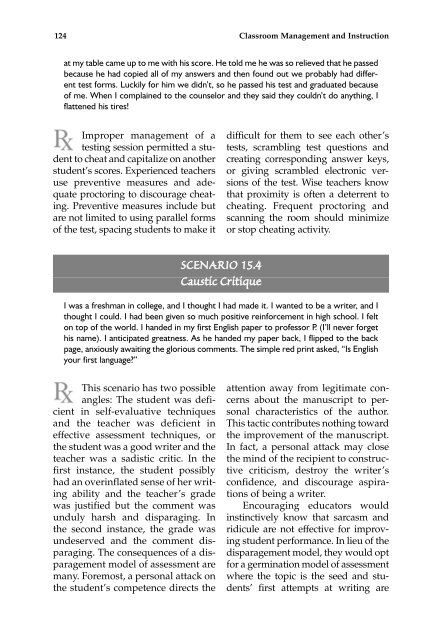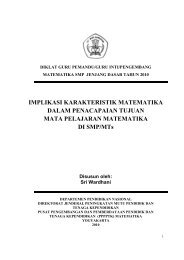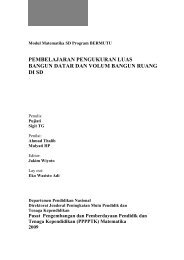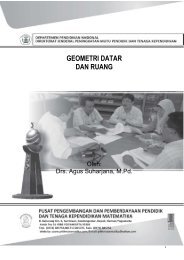25 Biggest Mistakes Teachers Make and How to Avoid Them
25 Biggest Mistakes Teachers Make and How to Avoid Them
25 Biggest Mistakes Teachers Make and How to Avoid Them
You also want an ePaper? Increase the reach of your titles
YUMPU automatically turns print PDFs into web optimized ePapers that Google loves.
124 Classroom Management <strong>and</strong> Instruction<br />
at my table came up <strong>to</strong> me with his score. He <strong>to</strong>ld me he was so relieved that he passed<br />
because he had copied all of my answers <strong>and</strong> then found out we probably had different<br />
test forms. Luckily for him we didn’t, so he passed his test <strong>and</strong> graduated because<br />
of me. When I complained <strong>to</strong> the counselor <strong>and</strong> they said they couldn’t do anything, I<br />
flattened his tires!<br />
Improper management of a<br />
testing session permitted a student<br />
<strong>to</strong> cheat <strong>and</strong> capitalize on another<br />
student’s scores. Experienced teachers<br />
use preventive measures <strong>and</strong> adequate<br />
proc<strong>to</strong>ring <strong>to</strong> discourage cheating.<br />
Preventive measures include but<br />
are not limited <strong>to</strong> using parallel forms<br />
of the test, spacing students <strong>to</strong> make it<br />
SCENARIO 15.4<br />
Caustic Critique<br />
difficult for them <strong>to</strong> see each other’s<br />
tests, scrambling test questions <strong>and</strong><br />
creating corresponding answer keys,<br />
or giving scrambled electronic versions<br />
of the test. Wise teachers know<br />
that proximity is often a deterrent <strong>to</strong><br />
cheating. Frequent proc<strong>to</strong>ring <strong>and</strong><br />
scanning the room should minimize<br />
or s<strong>to</strong>p cheating activity.<br />
I was a freshman in college, <strong>and</strong> I thought I had made it. I wanted <strong>to</strong> be a writer, <strong>and</strong> I<br />
thought I could. I had been given so much positive reinforcement in high school. I felt<br />
on <strong>to</strong>p of the world. I h<strong>and</strong>ed in my first English paper <strong>to</strong> professor P. (I’ll never forget<br />
his name). I anticipated greatness. As he h<strong>and</strong>ed my paper back, I flipped <strong>to</strong> the back<br />
page, anxiously awaiting the glorious comments. The simple red print asked, “Is English<br />
your first language?”<br />
This scenario has two possible<br />
angles: The student was deficient<br />
in self-evaluative techniques<br />
<strong>and</strong> the teacher was deficient in<br />
effective assessment techniques, or<br />
the student was a good writer <strong>and</strong> the<br />
teacher was a sadistic critic. In the<br />
first instance, the student possibly<br />
had an overinflated sense of her writing<br />
ability <strong>and</strong> the teacher’s grade<br />
was justified but the comment was<br />
unduly harsh <strong>and</strong> disparaging. In<br />
the second instance, the grade was<br />
undeserved <strong>and</strong> the comment disparaging.<br />
The consequences of a dispara<br />
ge ment model of assessment are<br />
many. Foremost, a personal attack on<br />
the student’s competence directs the<br />
attention away from legitimate concerns<br />
about the manuscript <strong>to</strong> personal<br />
characteristics of the author.<br />
This tactic contributes nothing <strong>to</strong>ward<br />
the improvement of the manuscript.<br />
In fact, a personal attack may close<br />
the mind of the recipient <strong>to</strong> constructive<br />
criticism, destroy the writer’s<br />
confidence, <strong>and</strong> discourage aspirations<br />
of being a writer.<br />
Encouraging educa<strong>to</strong>rs would<br />
instinctively know that sarcasm <strong>and</strong><br />
ridicule are not effective for improving<br />
student performance. In lieu of the<br />
disparagement model, they would opt<br />
for a germination model of assessment<br />
where the <strong>to</strong>pic is the seed <strong>and</strong> students’<br />
first attempts at writing are





